Introduction: Criminogenic Needs
- SMU Problems:
- 1,100 inmates;
- History of offenses in previous prisons;
- High recidivism rate;
- High rate of infractions while in incarceration;
- Solution and Goals:
- Criminogenic needs investigation;
- Multi-faceted evidence-based effort;
- Reduction of recidivism and infraction rates.
SMU is a federal prison with 1,100 inmates who have a history of infractions and offenses committed at their previous places of incarceration. They have a high recidivism rate (twice the normal), and their behavior involves multiple instances of infractions while incarcerated. The appropriate solution, which is currently supported by the US Department of Justice (2017), consists of investigating the criminogenic needs of the inmates and developing a comprehensive, multifaceted intervention with evidence-based approaches. The eventual goal is to reduce the recidivism and infraction rate that SMU currently experiences. In this presentation, three major approaches within the multifaceted effort will be discussed and justified.
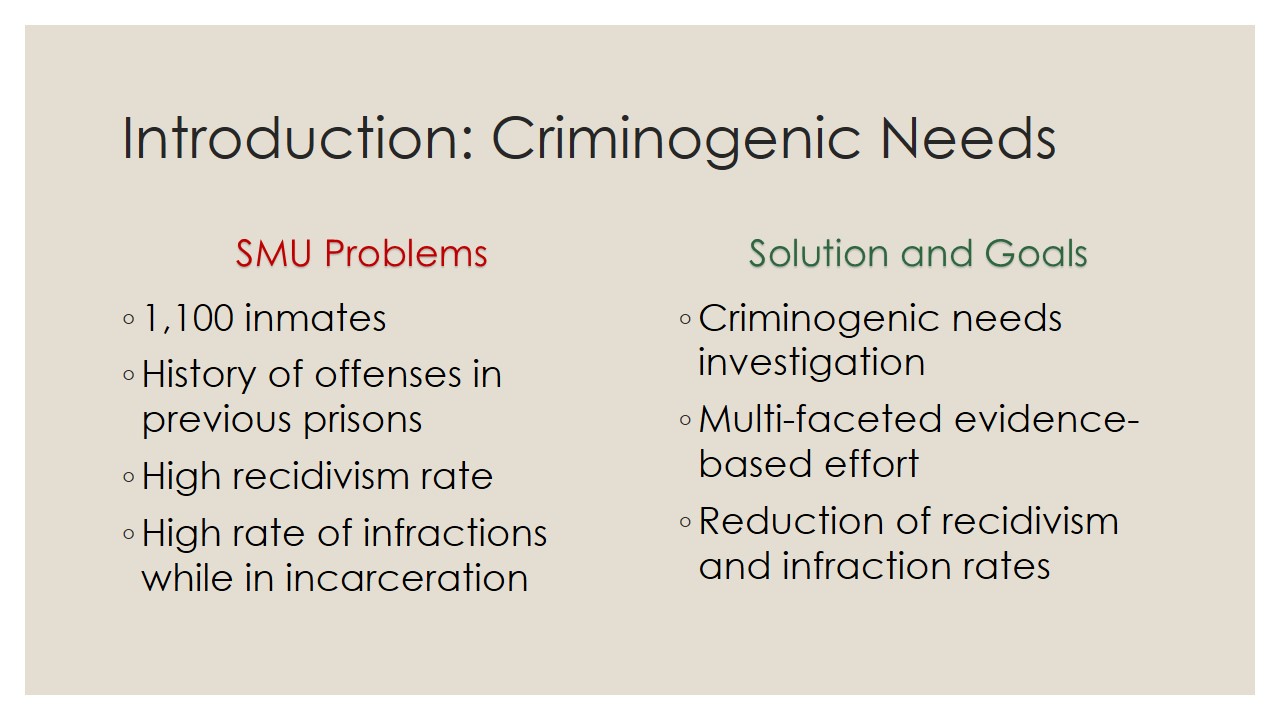
Approach 1: Mental and Spiritual Health
- Mental conditions: 58% of inmates (Rich, Allen, & Williams, 2014).
- Substance abuse: 50% of inmates (Rich et al., 2014).
- Mental issues contribute to recidivism (Prins, 2014).
- Addressing them may reduce recidivism (limited evidence) (Davis, Sheidow, & McCart, 2014).
- Addressing mental issues:
- Example: Illness Management and Recovery.
- Reducing addiction:
- Example: Houses of Healing (spiritual program).
- Working through trauma:
- Example: Seeking Safety (trauma and addiction management).
- Spirituality:
- Example: Threshold Program.
- Healthy families:
- Examples: Parenting Inside Out, InsideOut Dad.
- Mental health approach outcomes:
- management of issues;
- development of skills;
- quality of life improvement;
- ethical dilemmas understanding.
Mental health is of utmost importance for human functioning. It is not limited to the absence of mental conditions, but this topic is particularly important for inmates: half of them experiences a form of mental disorder, and half of them also reports substance problems (Rich et al., 2014). Those are general estimates (Prins, 2014), but it is generally acknowledged that inmates may have specific mental health needs.
Mental issues, including addiction, exist in a complex interrelationship with other problems and tend to be associated with poverty, homelessness, and unemployment. They may result in stigmatization and marginalization (Prins, 2014; Rich et al., 2014). All these factors can be viewed as criminogenic and conducive to recidivism, and there is also some limited evidence which indicates that by supporting mental health, prisons can reduce recidivism (Davis et al., 2014).
The specific approaches to improving the mental well-being of inmates are multiple. From here, the examples of programs will be taken from the “Inmate Model Programs Catalog” developed by the Federal Bureau of Prisons and supported by the US Department of Justice (2016). The programs are evidence-based and highly recommended for adoption in prisons. All of them are also labeled as appropriate for high-risk inmates, which makes them suitable for SMU.
Following the previous considerations, inmates may have mental health and addiction-related needs. Also, the US Department of Justice (2016) reports that a large number of inmates are survivors of domestic abuse. The programs that address all these issues must be introduced in SMU, and appropriate examples are presented in the slide.
As it was mentioned, mental health is not limited to the absence of illness. Programs that are based on various faith traditions aim to foster the spiritual and moral development of inmates. Other programs that are focused specifically on the improvement of inmates’ parenting skills work towards the restitution of familial ties and have a positive impact on inmates’ mental well-being (US Department of Justice, 2016).
All the mentioned programs are shown to assist inmates in the management of their mental issues, help them to develop a number of crucial interpersonal and self-care skills, and improve the quality of life for themselves and their families. Moreover, some of the programs, including those devoted to spirituality and healthy families, help inmates to develop more responsible attitudes and grow from the moral and ethical perspectives, which is important for their rehabilitation (Braswell, McCarthy, & McCarthy, 2017). Thus, the programs address some of the recidivism risk factors and can improve inmate behavior in incarceration.
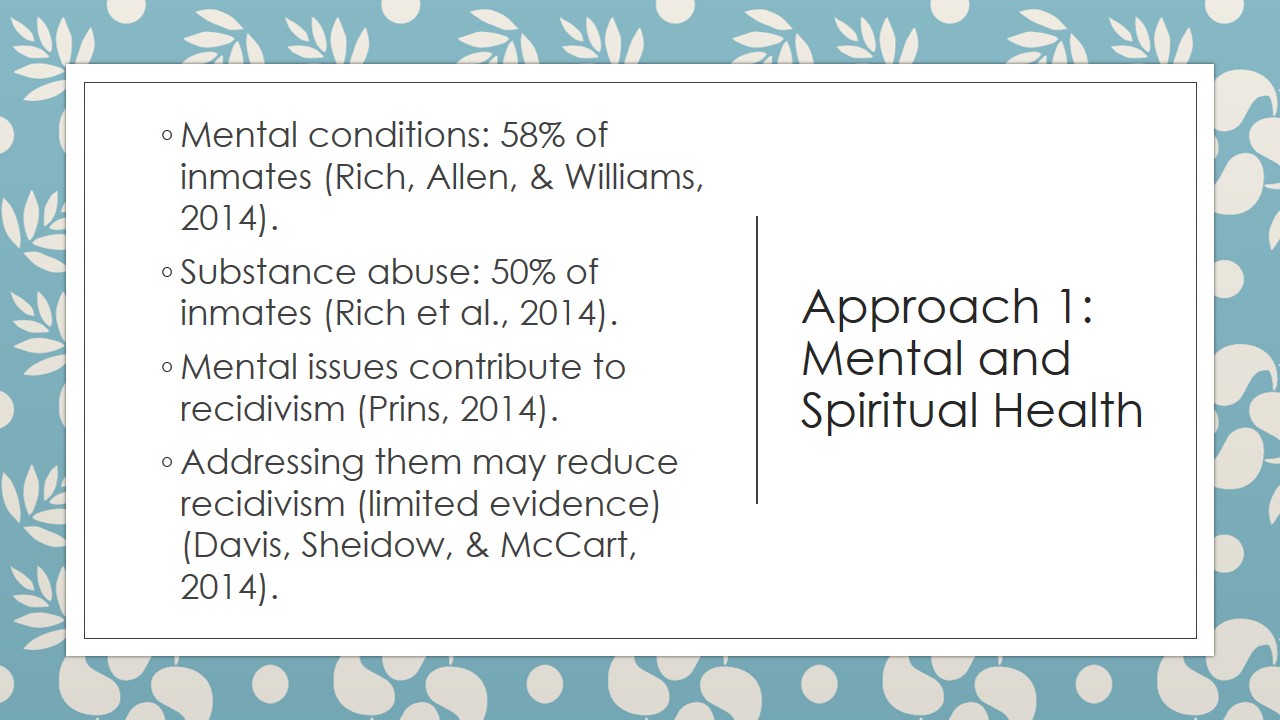
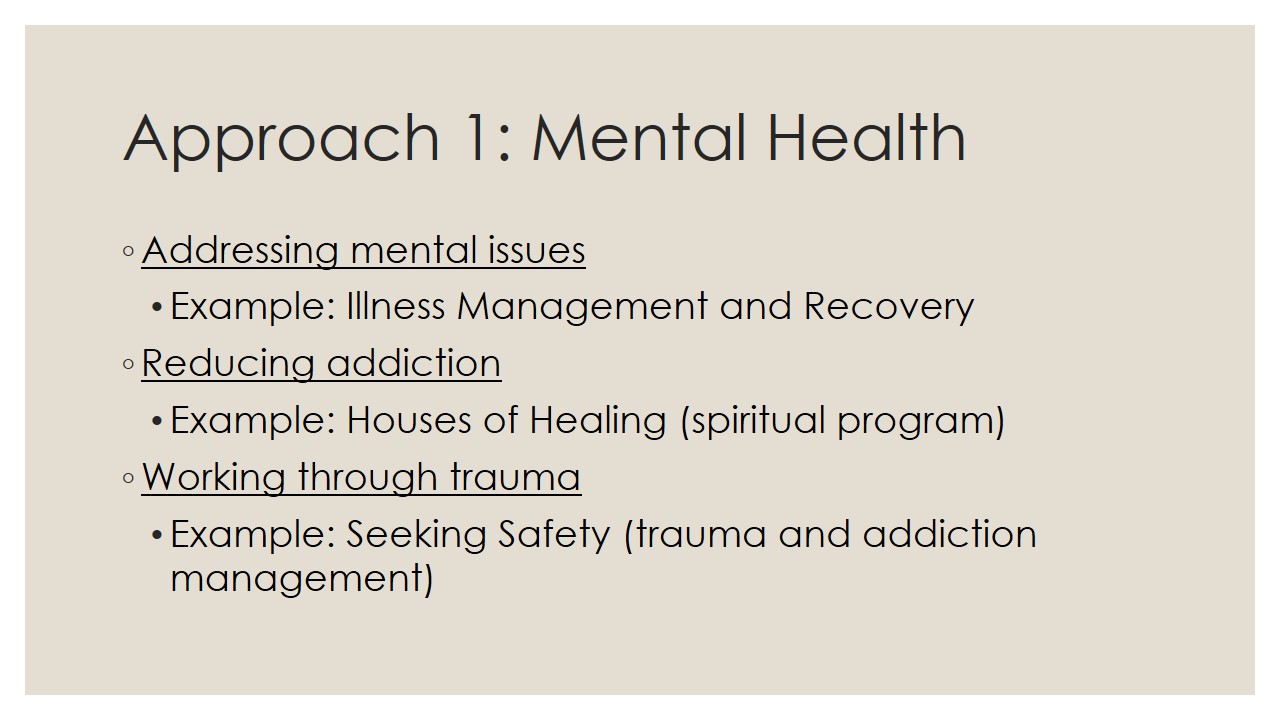
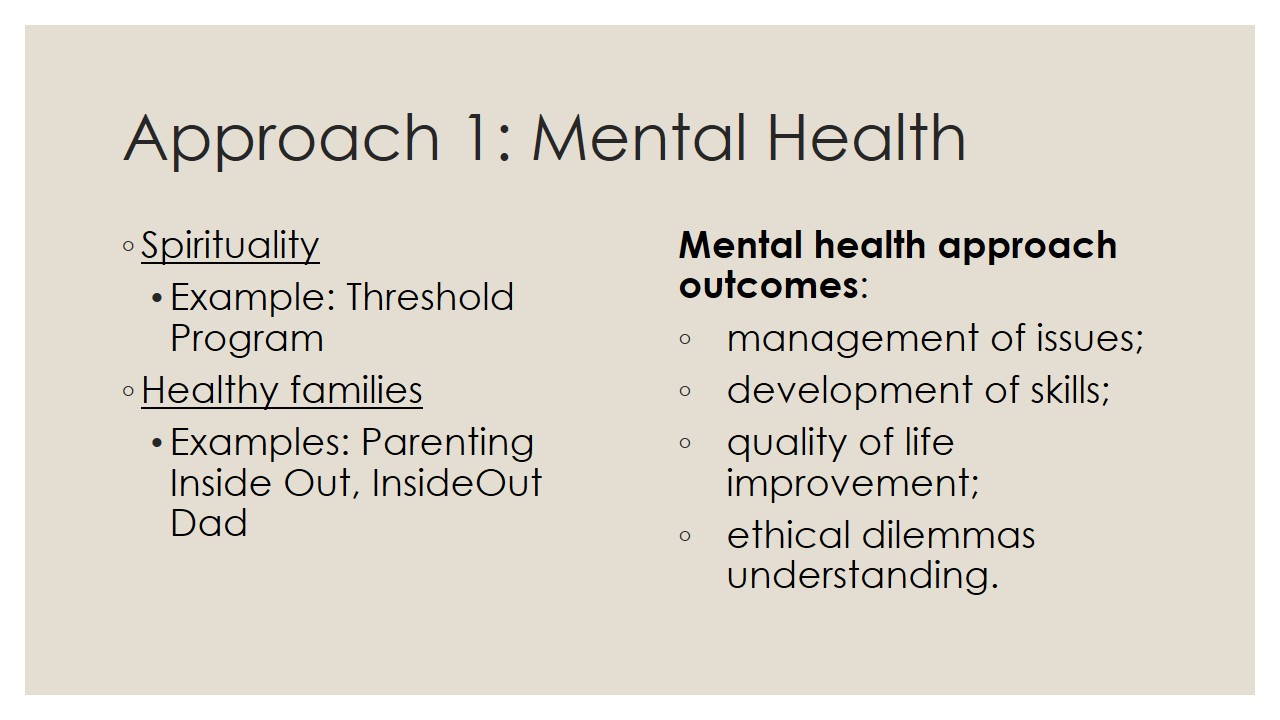
Approach 2: Financial Matters
- Unemployment, poverty – recidivism risk factors (Davis et al., 2014).
- Appropriate solutions:
- prison education (limited evidence) (Ellison, Szifris, Horan, & Fox, 2017);
- counseling;
- supported employment.
- Financial Counselling:
- Examples: Money Smart, AARP Foundation Finances 50+ (for older adults).
- Skills acquisition:
- Examples: Federal Prison Industries Lean Basics Training (vocational, interpersonal, and other skills).
- Supported employment programs:
- Example: Supported Employment (for mentally ill).
- Financial matters approach outcomes:
- needs assessment;
- skills and knowledge acquisition;
- 24% increase in the likelihood of employment (Ellison et al., 2017);
- reduction of the factors that contribute to recidivism.
Financial needs of inmates are addressed through the next element of the effort. Unemployment and poverty major risk factors for recidivism (Davis et al., 2014). They are also complex issues that are interrelated with problems like stigmatization (for example, the stigmatization related to prior incarceration), lack of education, homelessness, and other concerns (Davis et al., 2014; Prins, 2014). However, there is some limited evidence suggesting that education is an appropriate solution to the issue. Apart from that, supported employment programs and counseling are an option.
An example of the latter is financial counseling programs that are concerned with helping inmates to gain a better understanding of finance and develop related skills. Furthermore, prison education can involve the development of specific skills that will be of use for future employment, including vocational, interpersonal, and other ones. The US Department of Justice (2016) also supports a program that helps people with mental issues to find appropriate employment opportunities based on their needs and abilities.
Thus, the financial matters approach assesses the needs of inmates and provides them with the skills and knowledge that can help them to manage their financial matters better. As shown by Ellison et al. (2017) more research is needed on the topic, but prison education programs are associated with a 24% increase in the likelihood of being employed (on average). Consequently, at least one of the risk factors for recidivism is evidenced to be reduced as a result of these programs, which makes them appropriate for the present effort.
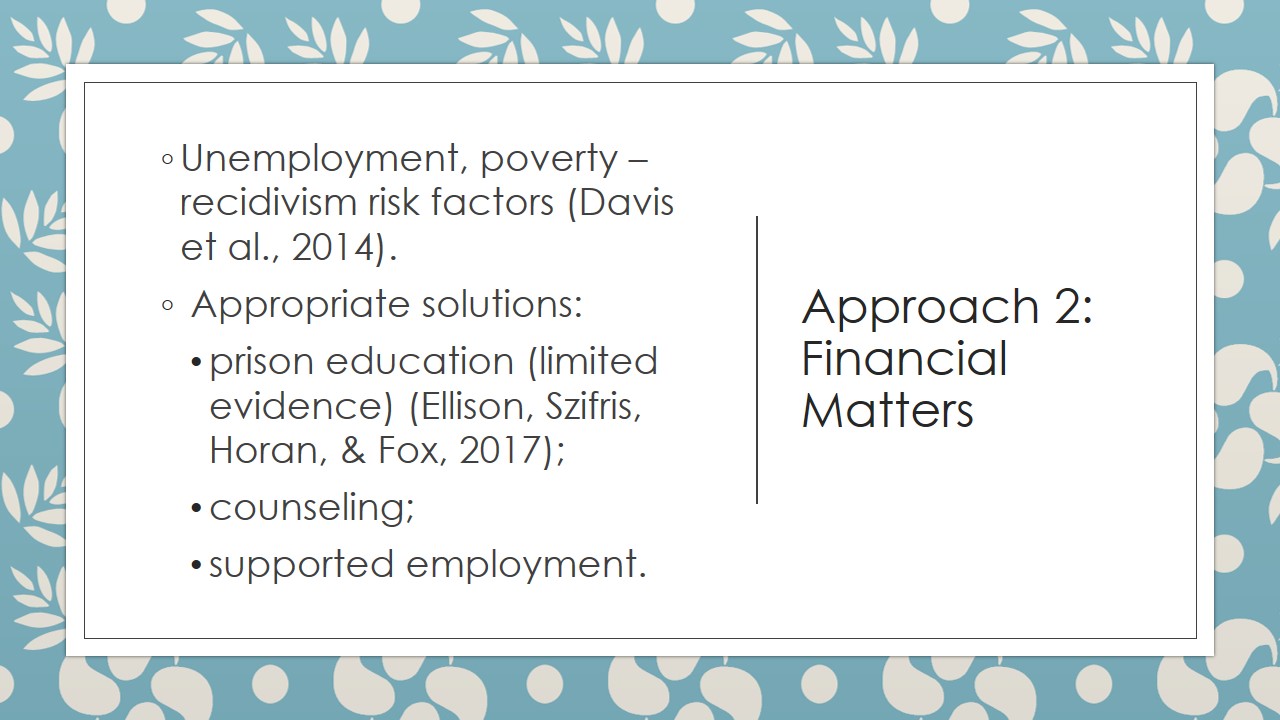
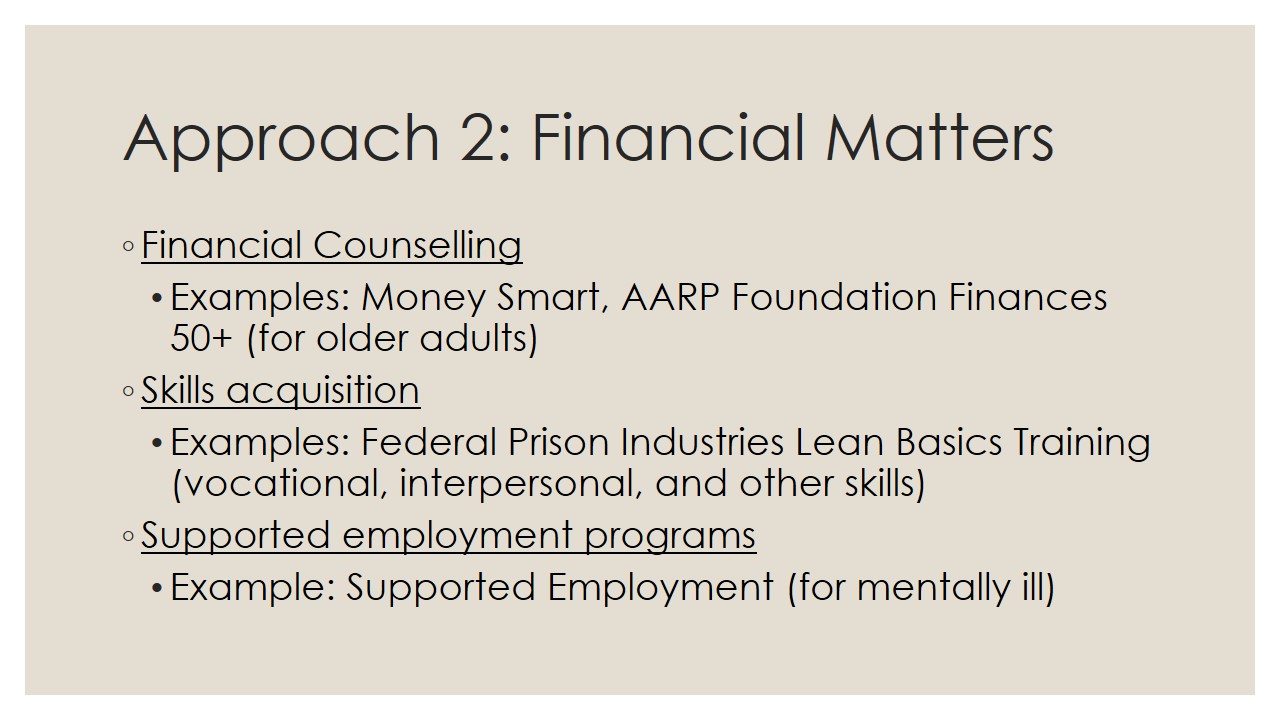
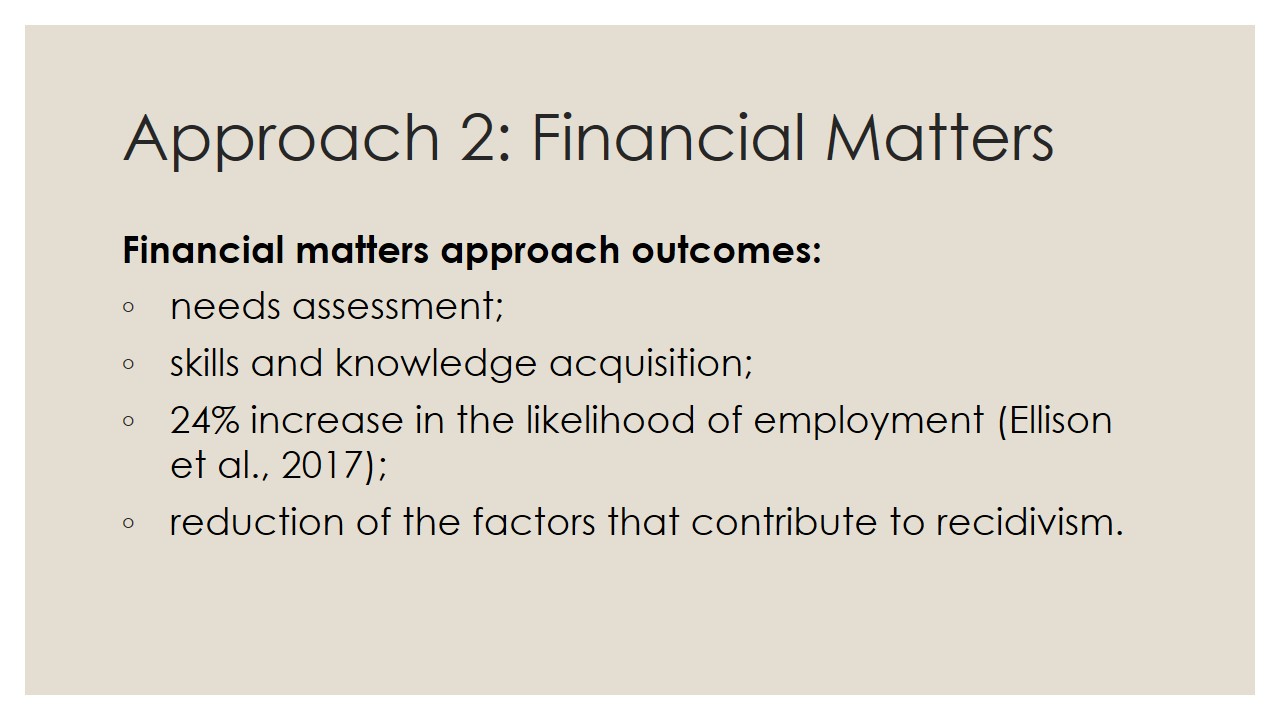
Approach 3: Self-Management
- Self-management aims:
- improved physical, mental, emotional, and spiritual well-being (US Department of Justice, 2016);
- responsible conduct (Sedelmaier & Gaboury, 2015).
- Emotional literacy:
- Examples: Houses of Healing (emotional literacy skills), Anger Management (recommended for high-risk inmates).
- Responsible conduct:
- Examples: Alternatives to Violence Program (spiritual), Victim Impact: Listen and Learn.
- Self-care:
- Examples: Wellness Recovery Action Plan (mental issues management), Anger Management.
- Self-management approach outcomes:
- improved self-care;
- Improved health (including mental health);
- improved quality of life (US Department of Justice, 2016);
- improved understanding of ethical dilemmas;
- improved responsibility (Sedelmaier & Gaboury, 2015).
The final element of the proposed effort consists of a wide variety of programs that are aimed at cultivating the inmates’ self-management skills. According to the US Department of Justice (2016), such programs improve the physical, mental, emotional, and spiritual well-being of inmates; also, they can be aimed at helping them to take responsibility for their actions.
One of the examples of such programs is the emotional literacy programs. For example, the Anger Management program is especially recommended by the US Department of Justice (2016) for high-risk inmates like those from the SMU. The ability of inmates to manage their emotions is further supported in the Alternatives to Violence Program, which uses spirituality to teach inmates to use means other than violence to resolve a conflict. Moreover, the Victim Impact: Listen and Learn is a highly recommended program that aims to rehabilitate inmates by improving their awareness of the impact that their actions have had on victims. Finally, there are programs that are tailored to the needs of inmates with specific conditions which may affect their health and well-being.
The self-management approach improves multiple aspects of self-management, including the ability to care for oneself, which results in improved health and quality of life. Moreover, the emphasis of some of the programs on ethics and human relationships contributes to the development of the understanding of the ethical and moral aspects of one’s lifestyle. Some of the programs are directly meant to help the inmates take responsibility for their actions (Sedelmaier & Gaboury, 2015). Overall, the self-management element is likely to contribute to inmates’ rehabilitation, reducing their risk of recidivism and improving their behavior while incarcerated. Thus, the proposed comprehensive effort targets criminogenic factors, incorporates the approaches that are tailored to the unique needs of the inmates, and contains the components that are evidenced to achieve the eventual goal of improved behavior and decreased recidivism in a way that is appropriate for SMU.
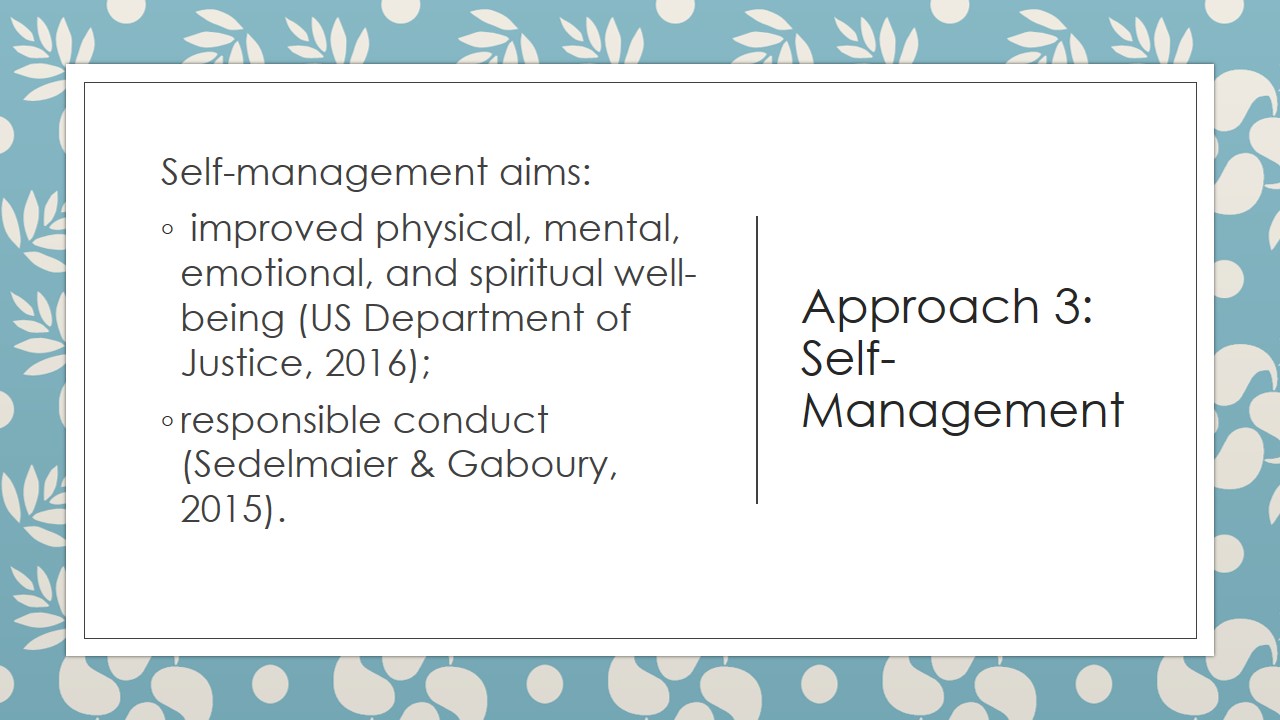
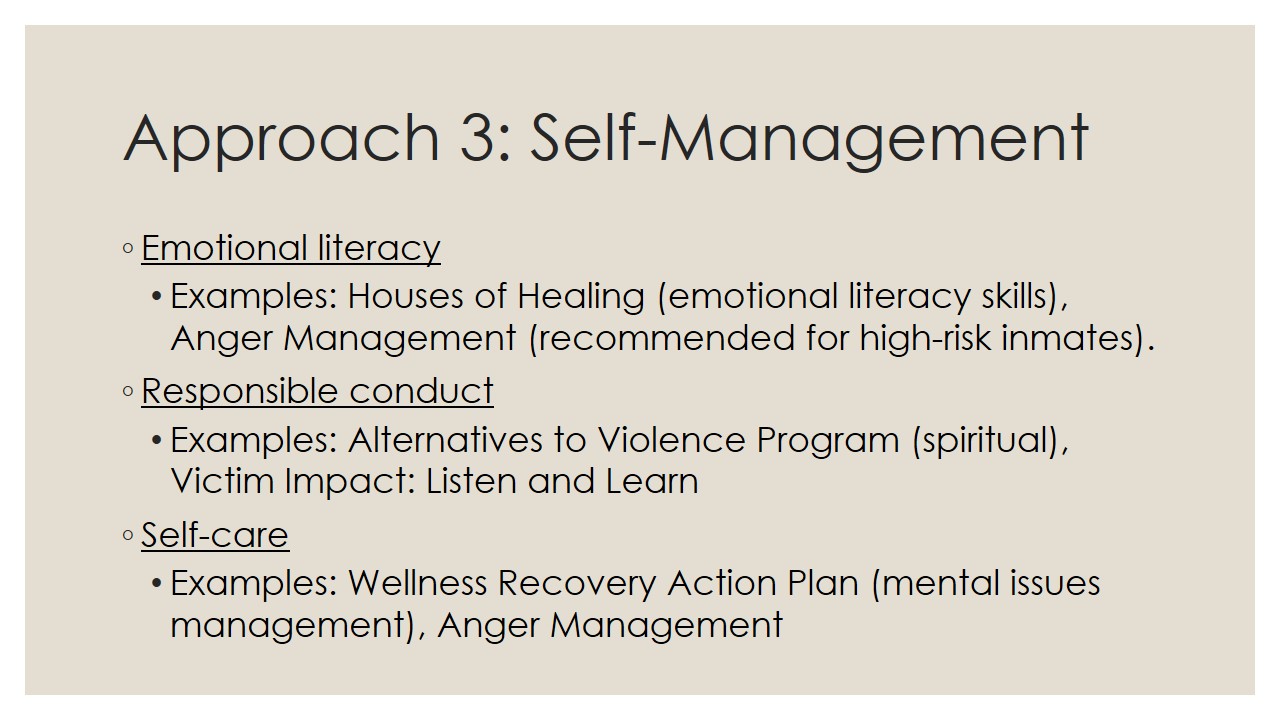
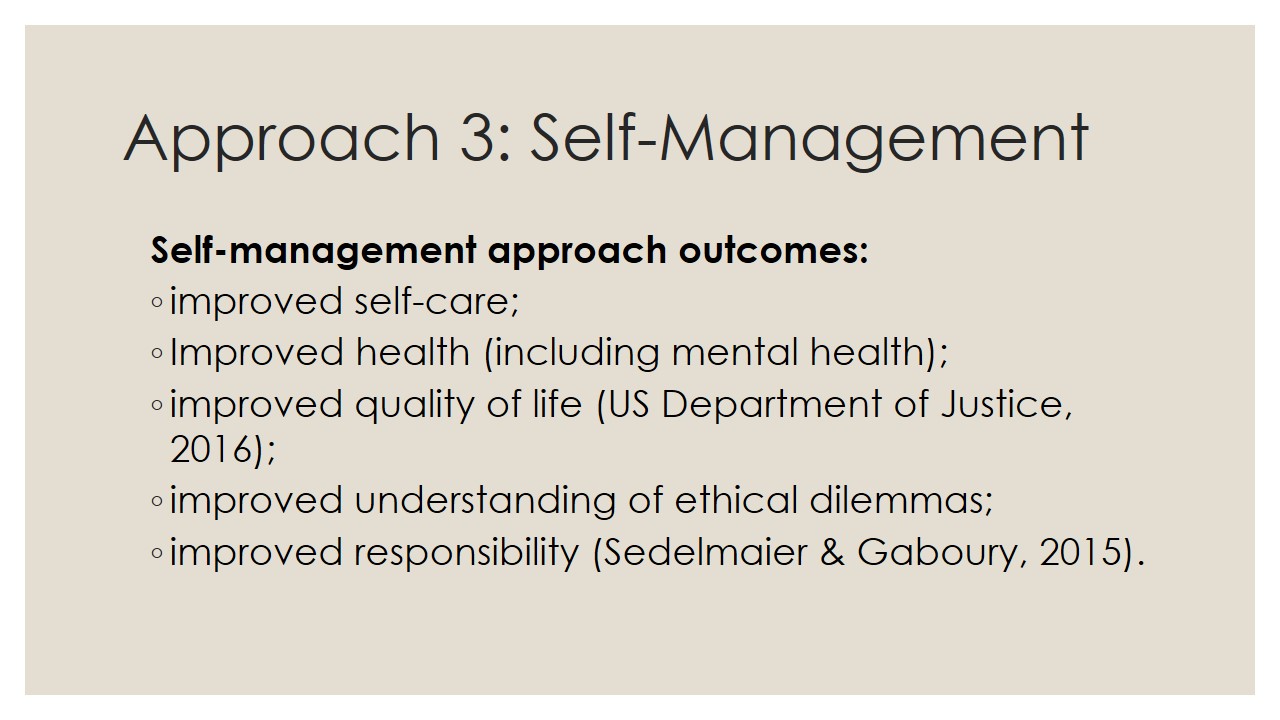
References
Braswell, M., McCarthy, B., & McCarthy, B. (2017). Justice, Crime, and Ethics. Florence: Taylor and Francis.
Ellison, M., Szifris, K., Horan, R., & Fox, C. (2017). A Rapid Evidence Assessment of the effectiveness of prison education in reducing recidivism and increasing employment. Probation Journal, 64(2), 108-128. Web.
Prins, S. (2014). Prevalence of mental illnesses in U.S. state prisons: A systematic review. Psychiatric Services, 65(7), 862-872. Web.
Rich, J., Allen, S., & Williams, B. (2014). The need for higher standards in correctional healthcare to improve public health. Journal of General Internal Medicine, 30(4), 503-507. Web.
Sedelmaier, C., & Gaboury, M. (2015). Administering a victim impact curriculum to inmates: a multi-site replication. Criminal Justice Studies, 28(2), 226-238. Web.
US Department of Justice. (2016). Inmate model programs catalog. Web.
US Department of Justice. (2017). Prison reform: Reducing recidivism by strengthening the federal bureau of prisons. Web.